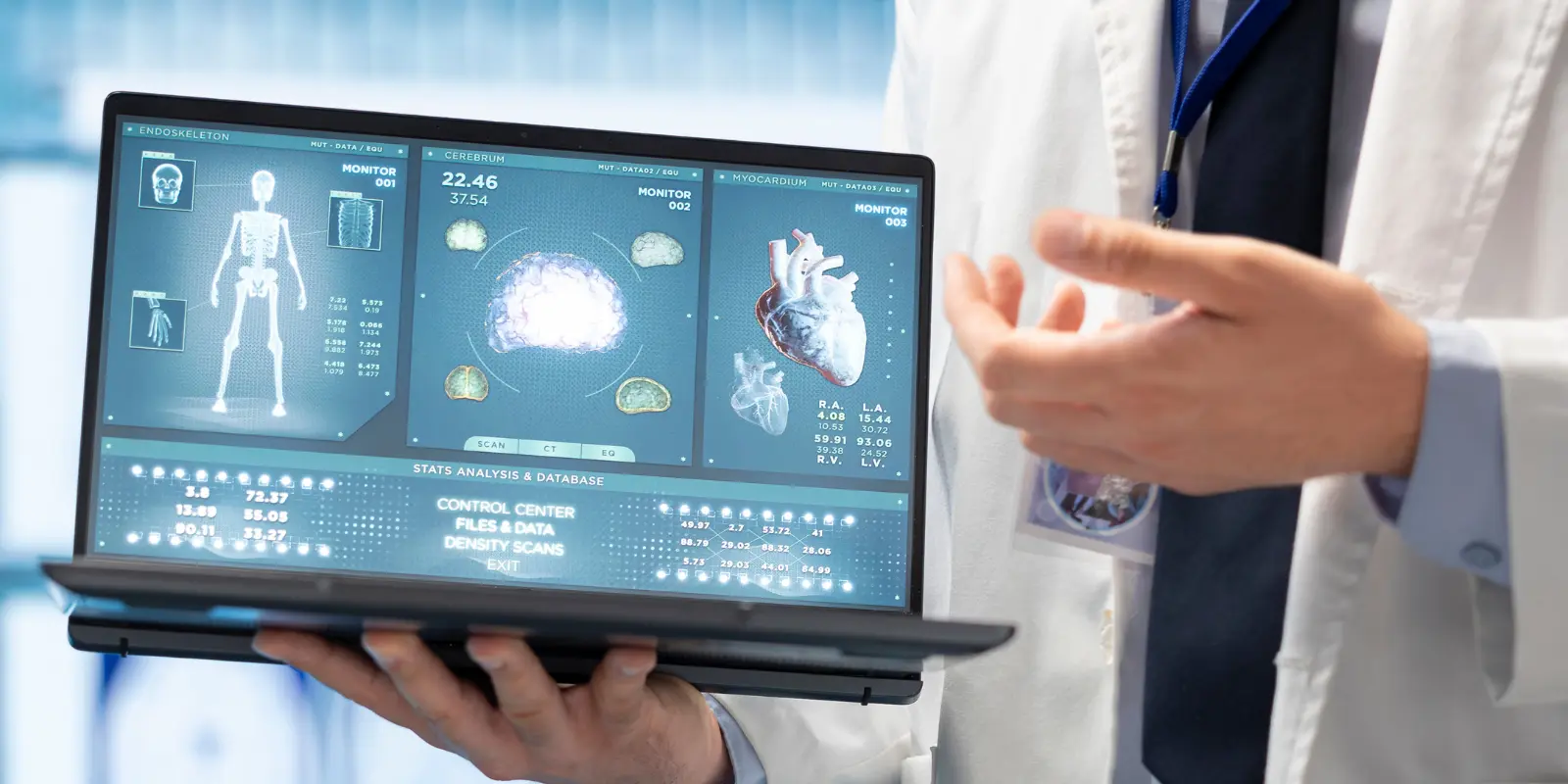

Teleradiology
The Future of MRI: Advancements and AI Integration in Online MRI Reporting
Introduction
Imagine being unwell, yet no diagnostic test identifies the root cause. This is a frustrating reality for many patients, often due to the limitations of traditional imaging methods like X-rays. Magnetic Resonance Imaging (MRI) has revolutionized healthcare by offering detailed, high-resolution images of soft tissues, playing a crucial role in identifying tumors, neurological conditions, and more.
However, traditional MRI procedures can be time-consuming and intimidating. The integration of Artificial Intelligence (AI) and online MRI reporting in India is rapidly transforming this landscape. These advancements promise faster scans, more precise analysis, and better accessibility—even in remote areas—through services like online MRI report readers and online MRI report check platforms.
Understanding MRI and Its Importance
MRI is a non-invasive imaging technique that uses magnetic fields and radiofrequency waves to visualize internal organs and tissues. Unlike X-rays or CT scans, MRI does not use ionizing radiation, making it safer for repeated imaging, especially in vulnerable populations like children and pregnant women.
Its superior ability to image soft tissues makes MRI ideal for diagnosing:
- Brain and spinal cord conditions
- Musculoskeletal injuries
- Cardiovascular anomalies
- Tumors and cancer staging
With the rise in demand for how to report MRI brain and how to study MRI report online, MRI has also become more user-friendly and accessible through digital platforms.
Challenges in Traditional MRI Procedures
Despite its many advantages, conventional MRI still poses several challenges:
Lengthy Scan Times
MRI scans typically range from 15 to 60 minutes. Patients must remain still, which can be difficult, especially for children, elderly patients, or those in pain.
Claustrophobia and Anxiety
The enclosed space and loud noise of MRI machines can cause discomfort or panic attacks in some patients, often leading to incomplete or aborted scans.
Limited Access
High installation and maintenance costs make MRI machines scarce in rural or resource-limited areas. This delay in diagnosis often results in worse outcomes for patients.
The Role of AI in Transforming MRI
AI-powered MRI systems are paving the way for faster, smarter, and more accessible scans. Here's how:
Accelerated Imaging
AI can streamline image acquisition protocols, reducing scan times significantly while maintaining image clarity. This leads to improved patient comfort and faster throughput.
Enhanced Image Quality
AI-based reconstruction techniques deliver sharper, clearer images, improving the detection of subtle abnormalities. Early diagnosis becomes easier, especially in brain imaging, where precise analysis is critical.
Automated Analysis and Reporting
AI algorithms can:
- Detect and measure lesions
- Highlight abnormal regions
- Suggest possible diagnoses
This assists radiologists by reducing errors and turnaround times in reporting. For those seeking guidance on how to study MRI report, AI-based tutorials and structured reporting can be extremely helpful.
The Rise of Online MRI Reporting in India
A significant breakthrough in radiology is the advent of online MRI reporting in India, allowing radiologists to remotely review and interpret scans via secure digital platforms.
Benefits of Online MRI Report Readers:
- Faster diagnosis with 24/7 access to radiology services
- Specialist consultation available even in tier-2 and tier-3 cities
- Reduced patient travel, making advanced imaging more accessible
- Support for how to report MRI brain through templates and AI-based suggestions
Many platforms also allow patients to check MRI reports online, empowering them to take ownership of their health and understand their medical condition better.
Remote Diagnostics and Second Opinions
AI enables remote MRI diagnostics, allowing experts from across the world to weigh in on complex cases. This is a game-changer for underserved or geographically isolated populations. For instance, if someone in a small town needs a second opinion, they can now upload and check MRI reports online, ensuring timely and accurate care.
Making MRI More Patient-Friendly with AI
AI integration isn’t just about technology; it’s about improving patient experiences. Here’s how:
Personalized Scan Protocols
AI can adjust imaging parameters based on the patient's anatomy, clinical question, and previous scan results, ensuring optimal comfort and efficiency.
Predictive Maintenance
AI helps track the health of MRI equipment, reducing downtime and ensuring consistent service availability—especially important for high-demand settings.
AI-Driven Patient Education
Virtual assistants and VR tools powered by AI help explain the MRI process to patients beforehand, reducing fear and improving compliance.
Outlook: What Lies Ahead?
The future of MRI and online MRI reporting is full of exciting possibilities:
Real-Time Imaging
We’re moving toward real-time, dynamic imaging that will help surgeons during procedures or guide emergency interventions.
Portable MRI Machines
AI is enabling the development of compact, portable MRI devices, making it possible to take imaging directly to the patient—ideal for ICUs, ambulances, and rural clinics.
Predictive Diagnostics
AI can analyze MRI data to predict disease progression, enabling early intervention and more personalized treatment plans.
This also complements the growing trend of online MRI report readers who can monitor patient history over time and offer predictive insights.
Conclusion
The convergence of MRI technology, Artificial Intelligence, and online MRI reporting in India is setting new benchmarks in diagnostic imaging. From improved patient comfort to faster diagnoses and better access to expert opinions, the benefits are immense.
For healthcare providers and patients alike, embracing tools that let you check MRI report online, understand how to report MRI brain, and learn how to study MRI report can vastly enhance healthcare outcomes.
As innovation continues, the focus will remain on making MRI more accurate, accessible, and patient-centered, bringing quality diagnostics within everyone’s reach.
Moreover, with increased adoption of online MRI report readers, radiologists can collaborate in real-time and generate faster, AI-augmented reports. This not only shortens diagnostic timelines but also improves accuracy. The future promises even more: AI-driven triage systems, patient portals offering instant report access, and personalized alerts based on scan results. These advancements are democratizing healthcare, especially in regions with limited specialist access. By leveraging these tools, patients and clinicians are better equipped to make timely, informed decisions. The age of smart, accessible, and precise MRI has truly arrived—and it's powered by AI and digital connectivity.
FAQs
MRI online reporting refers to the remote interpretation of MRI scans by qualified radiologists who access images via secure digital platforms and provide reports electronically.
Yes, it is highly reliable when performed by experienced radiologists using high-quality imaging and secure platforms. Many hospitals and diagnostic centers rely on online reporting for timely and expert opinions.
All MRI scans are interpreted by board-certified senior radiologists with specialized experience in various subspecialties, ensuring accurate and detailed reports.
Turnaround time varies but is typically within a few hours to 24 hours, depending on the urgency and complexity of the case.
Yes. We use encrypted and HIPAA/GDPR-compliant systems to ensure the confidentiality and security of patient data during transmission and storage.
Absolutely. Many teleradiology services offer stat (urgent) reporting options to prioritize emergency cases and deliver results promptly.
Reports are usually shared through a secure portal or directly with your referring physician. Some platforms also allow patients to log in and view their reports.
More from AMI
How Aster Medical Imaging’s Nighthawk Service Enhances Brain Neuroimaging
29/09/2025
Improvement of Patient Care Through Teleradiology
03/07/2023
Cardiovascular Imaging: Expanding Access to Advanced Heart Care with Teleradiology
29/09/2025
Emerging Techniques in Radiology By Dr. Namita
10/11/2022
Radiology Online Reporting: Transforming Diagnosis with Speed and Accuracy
31/07/2025
Behind The Scenes of Teleradiology: How Digital Imaging Is Changing Diagnostic Medicine
16/10/2023
How to Increase the Efficiency of the Radiology Equipment
21/08/2023
Imaging In Pregnancy
18/01/2023
Intra- Operative 3D Imaging With O- Arm Making Complex Spine Surgeries Safe and Accurate
30/11/2022
What is Diagnostic Radiology? Understanding its Tests and Procedures
14/08/2023
How Teleradiology Reporting Services Are Revolutionizing Frozen Shoulder Diagnosis and Reporting
17/11/2025
Advances In Neuroradiology
06/01/2023
Unlocking the Knee: How Tele-Reporting Service Empowers Clinicians
25/11/2025
MRI Spine Thoracic: How Teleradiology Enhances Faster, Accurate Diagnosis
29/09/2025
Teleradiology's Contribution to Timely Emergency Diagnoses
04/10/2023
Scope of Radiologist in India
29/08/2023
How Teleradiology Supports Musculoskeletal Pain Specialists in Diagnosis
20/08/2025
How to Choose a Prospective Teleradiology Service Provider
07/08/2023
Sports-Related Injuries and the Importance of Radiology
30/01/2023
Why Hospitals Prefer Teleradiology Outsourcing for Accurate and Timely MSK Injury Reports
14/11/2025
Revolutionizing Indian Healthcare: Unlocking the Potential of Teleradiology in Remote Areas
27/09/2023
10 Strategies To Prevent Burnout In Radiology
09/01/2023
Empowering Radiologists-Teleradiology Redefines the Role of Imaging Specialist
09/10/2023
Imaging Instrumentation Trends In Clinical Oncology
26/06/2023
How Teleradiology Solutions Help Hospitals Cut Turnaround Time
20/08/2025
Radiology Practices
30/11/2022
Emerging Trends and Technologies in Medical Imaging
19/06/2023

AMI Expertise - When You Need It, Where You Need It.
Partner With Us
